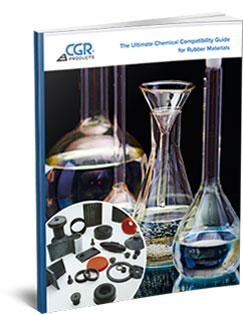The General Chemical Resistance of Various Elastomers
This chart is offered only as a general guide, indicating the suitability of various elastomers for service in these chemicals and fluids. The ratings are based for the most part, on published literature of various polymer suppliers, rubber manufacturers, and in some cases, the considered opinion of experienced compounders. We cannot guarantee their accuracy nor assume the responsibility for use thereof. Many factors must be considered in using a rubber part in service. The most important as we see them are:
- Temperature of service: Higher temperatures increase the effect of all chemicals on polymers. The increase varies with the polymer and the chemical. a compound quite suitable at room temperature might fail miserably at elevated temperature.
- Conditions of Service: A compound that swells badly might still function well as a static seal yet fail in any dynamic application.
- The Grade of the Polymer: Many types of polymers are available in different grades that vary greatly in chemical resistance.
- The Compound itself: compounds designed for other outstanding properties may be poorer in performance in a chemical than one designed especially for fluid resistance.
- The Durometer: In general, the harder a compound the better its resistance.
In light of the above factors, it’s always best to test.

For a FREE downloadable PDF version to keep for your records:
Download the full version of the Chemical Compatability Guide Here